
The Project Gutenberg EBook of An Illustrated Handbook of Mount Vernon, by
Mount Vernon Ladies' Association
This eBook is for the use of anyone anywhere in the United States and most
other parts of the world at no cost and with almost no restrictions
whatsoever. You may copy it, give it away or re-use it under the terms of
the Project Gutenberg License included with this eBook or online at
www.gutenberg.org. If you are not located in the United States, you'll have
to check the laws of the country where you are located before using this ebook.
Title: An Illustrated Handbook of Mount Vernon
The Home of Washington
Author: Mount Vernon Ladies' Association
Release Date: November 19, 2017 [EBook #55997]
Language: English
Character set encoding: UTF-8
*** START OF THIS PROJECT GUTENBERG EBOOK ILLUSTRATED HANDBOOK--MOUNT VERNON ***
Produced by Stephen Hutcheson and the Online Distributed
Proofreading Team at http://www.pgdp.net


Mount Vernon, the Home of George Washington
Purchased (in 1858), restored and maintained by the
Mt. Vernon Ladies’ Association of the Union
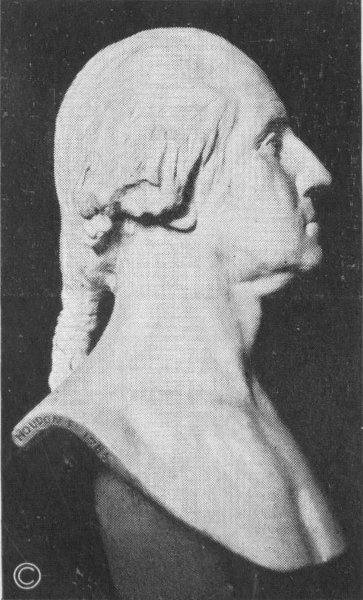
Houdon’s Bust of Washington
Made at Mount Vernon, 1785
Copyright, 1928, by the
Mount Vernon Ladies’ Association
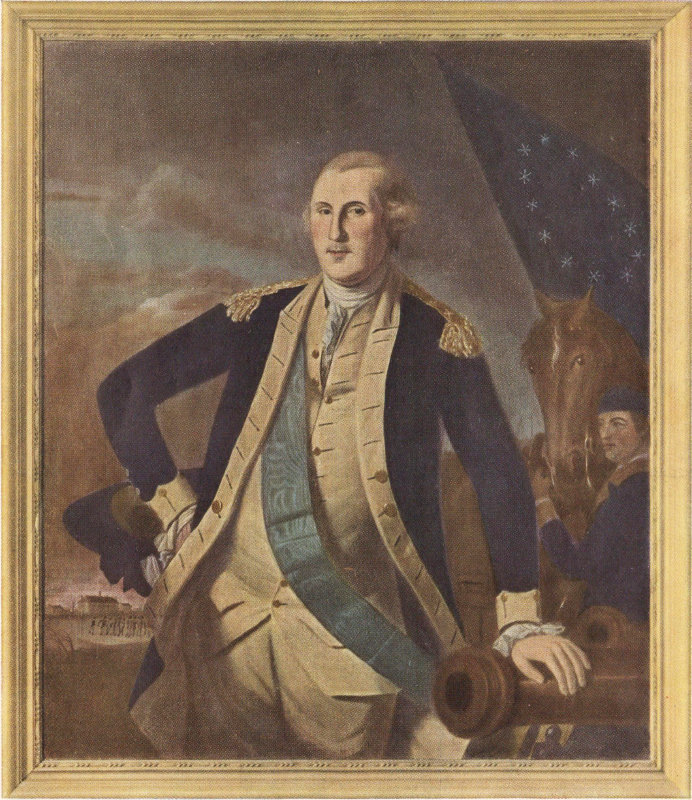
Portrait of George Washington
By Chas. Wilson Peale
Bequeathed to the Mount Vernon Ladies’ Association by the late Miss Jane Boudinot, in whose family’s possession the portrait has been since 1788, when it was painted (from life) for Elias Boudinot
In the year 1674, by Grant of Lord Culpeper, a tract of 5,000 acres situated on the west bank of the Potomac River, fifteen miles south of the present city of Washington, became the property of John Washington and Nicholas Spencer. Half of this tract, or 2,500 acres, descended to Lawrence Washington, who, in 1743, built a residence, and named the estate Mount Vernon, after the British Admiral under whom he had served. At Lawrence Washington’s death (1752) the estate passed to the ownership of his half brother, George Washington, who subsequently extended the boundaries of his plantation until they included nearly 8,000 acres.
In 1799, when George Washington died, the property passed as a life interest to his widow, by whose will most of the household effects in the Mansion were, after her death, divided among her four grandchildren. Thus was the original furniture of Mount Vernon eventually scattered.
Bushrod Washington, John Augustine Washington, and John A. Washington, Jr., followed in succession as owners of Mount Vernon.
These gentlemen furnished the Mansion according to their individual tastes and made such minor changes as papering or painting the interior to preserve it.
Mr. John A. Washington, Jr., the last-named owner, in accordance with the wishes of his family, to effect a permanent preservation of the property, offered to sell it to the National Government. This project failed, as did likewise an attempt to sell to the Commonwealth of Virginia.
At this juncture the Mount Vernon Ladies’ Association of the Union was (in 1856) organized by Miss Pamela Cunningham, of South Carolina. Her appeal to the patriotism of all American women (December, 1853) resulted in the accomplishment of her noble project in spite of many obstacles. The purchase money was raised by contributions from thirty-three States of the Union, materially aided by Hon. Edward Everett, of Massachusetts, in lecturing for the benefit of the Mount Vernon Fund, his contributions amounting to $68,294.59. In 1858, this Association was thus enabled 4 to buy from Mr. John A. Washington, Jr., and his heirs, 202 acres of the Mount Vernon estate, including the Tomb, the Mansion, attendant buildings, the wharf, etc., the price paid being $200,000 and interest.
In 1887, an important addition of 33½ acres was achieved through the generosity of the late Mr. Jay Gould, of New York; in 1893 Mr. Christian Heurich, of Washington, D. C., gave three acres, and in 1925 Mr. and Mrs. Hugh McK. Landon, of Indianapolis, kindly donated about 23 acres more, thus making the total area owned by the Mt. Vernon Ladies’ Association approximately 260 acres.
Among the many who visit Mount Vernon few are aware of what an expensive undertaking is involved in its restoration and preservation, nor do they realize on entering its gates that they, too, contribute their mite toward the maintenance of this historic place. To retain the appearance of that simplicity which characterized the home life of Washington, to preserve the reverence of his hallowed shrine and at the same time meet the protective requirements incident to increasing wear and tear, has been a problem to be mastered.

Mt. Vernon when purchased by the Mt. Vernon Ladies’ Association of the Union
While the employment of modern appliances has become a necessity, they are masked as much as possible to avoid glaring contrast with the more primitive methods of olden times. For instance: to guard against accidents by fire all former and dangerous means of heating the buildings have given place to a hot water system, the 5 mains of which pass through subterranean conduits from a distant (underground) boiler room, and all buildings are lighted by a system of low voltage electricity installed under the direction of Mr. Edison.
Fire engines—both chemical and steam—are at hand for instant use, and guards are on constant watch both day and night. Powerful modern pumps (electrically driven) supply water from an artesian well for household purposes, and keep the emergency reservoirs filled. Sanitary drainage is an essential improvement. Bogs and swamps have been reclaimed to make the place more healthful.
Threatening landslides near the Mansion and old Tomb were averted by the costly expedient of tunneling the hill to drain the water-bearing sands, the source of disastrous surface movements which had caused Washington much alarm.
The Association owes to the interest and patriotism of Prof. Charles Sprague Sargent, of Arnold Arboretum, the replacement and listing of many trees planted at Mount Vernon during Washington’s lifetime. A plan with the position of all historic trees is shown in the guide book. Successful efforts have been made to replant both the grounds of the Mansion and the surrounding woods according to Washington’s original idea as expressed in his diary.
The repair and safeguarding of buildings and their contents, attention to the old trees Washington loved, his roads, walks, gardens and grounds, continually tax the energy and resources of the Association. That the steadfast aim and purpose, thus successfully achieved, is appreciated by those who are familiar with it, is admirably expressed in the concluding chapter of Owen Wister’s “Seven Ages of Washington.” The following is a brief quotation:
“Everything, every subject, every corner and step, seems to bring him close. It is an exquisite and friendly serenity which bathes one’s sense, that seems to be charged all through with some meaning or message of beneficence and reassurance, but nothing that could be put in words. Turn into his garden and look at the walls and walks he planned, the box hedges, the trees, the flower beds, the great order and the great sweetness everywhere. You may spend an hour, you may spend a day, wandering, sitting, feeling this gentle power of the place; you may come back another time, it meets you, you cannot dispel it by familiarity. And as you think of this you bless the devotion of those whose piety and care treasure the place and keep it sacred and beautiful.

Unless otherwise designated all the tailpieces in this book represent original furnishings in use at Mount Vernon during the lifetime of General Washington.”
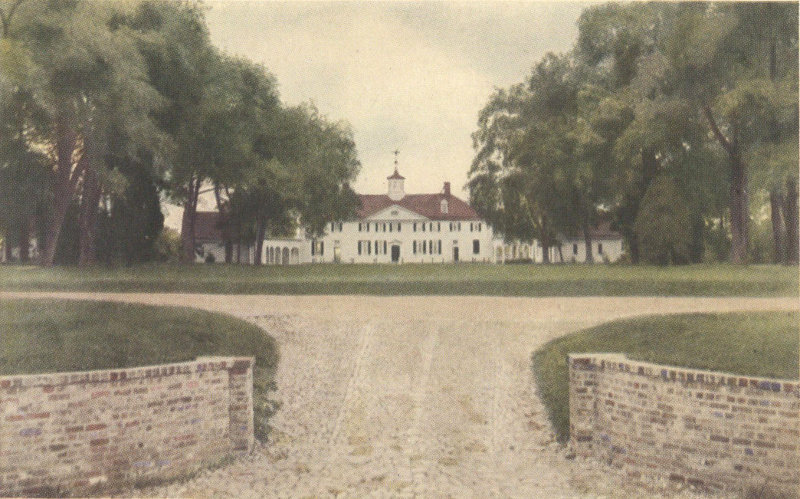
Through this gateway Washington and his guests were accustomed to pass from the main road. The original paving of cobble stones has been found intact and now visitors to Mount Vernon enter as in Washington’s time. An attractive bowling-green extends from the gateway nearly to the Mansion. To the left are the flower gardens, and occupying a similar area to the right is the kitchen garden. These gardens are surrounded by brick walls, the coping of which was restored, in 1895, by Mrs. Christine Blair Graham, late Vice-Regent for Missouri.
Many of the old trees still bordering the original driveway have been identified from Washington’s diary as having been planted by him or his guests. Notably among them may be seen, near the Flower Garden entrance, two handsome tulip poplars—the tallest trees of the group.
On the lawn facing the Potomac are three large pecan trees which, as seedlings, came from Thomas Jefferson and were planted by Washington.

Sword worn by General Washington when he resigned Command of the Army in 1783, when he was inaugurated first President of U.S. 1789 and on all subsequent State occasions

The west front of the Mansion was the point of approach for visitors, as indicated by the large central door bearing the original brass knocker. On this side is a spacious court, flanked by several frame buildings—to the right, the kitchen, butler’s house, smoke-house, laundry and coach house, while to the left are the office, the gardener’s house, carpenter shop and spinning house.
The kitchen and office are joined to the main building by colonnades, which were rebuilt in 1874 by the combined efforts of the late Vice-Regents for six States, as follows: Mrs. Hannah Blake Farnsworth, Michigan; Miss Lily Lytle Macalester, Pennsylvania; Miss Emily L. Harper, Maryland; Mrs. Lucy H. Pickens, South Carolina; Mrs. Maria Brooks, New York, and Mrs. Nancy Wade Halstead, New Jersey.
The sun-dial in the center of the court marks where one stood in the days of Washington. The posts and chains are a restoration of an original feature, accomplished in 1917 by the Vice-Regent for Oregon.

Sword worn by Col. Washington as aide to General Braddock
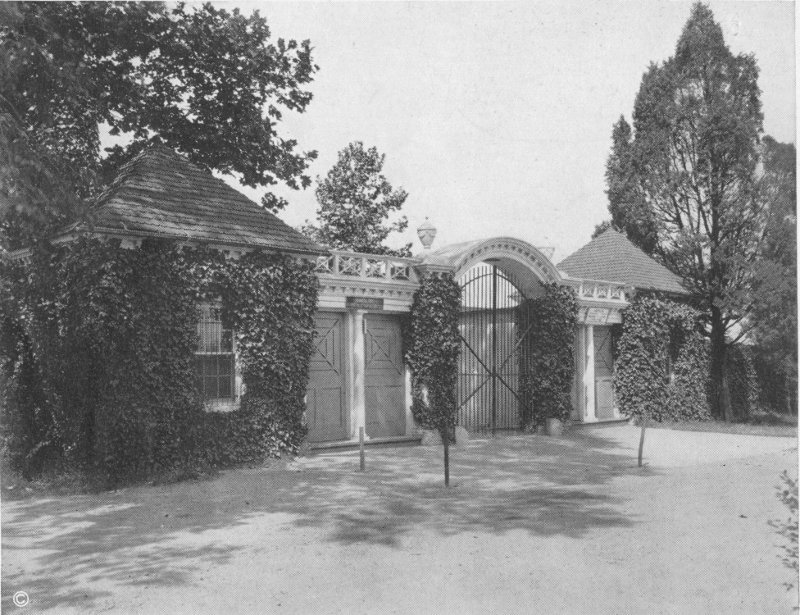
In 1892, when the Electric Railway located its terminal station near the north boundary of the estate, an entrance at that point had to be arranged for visitors. It is called the North Lodge Gate to distinguish it from the private entrance half a mile away. To provide an appropriate walkway to and from the Mansion, funds were raised, in 1894, by the late Vice-Regent for Pennsylvania—Mrs. Lippincott—and stone flagging laid the entire distance of 1,100 feet.
In 1900 the Vice-Regent for Texas, with financial aid from Masons and other patriotic citizens of her State, erected the present lodges and gateway.
The Vice-Regent for Texas and Mrs. Charles Denby, late Vice-Regent for Indiana, in 1905, jointly arranged for the building of a brick wall along the boundary next the North Lodge Gate, copying walls built elsewhere on the estate by General Washington.
The gradual extension of this wall is being accomplished through contributions of individual members of the Association.

Dress sword worn by General Washington

This was the main approach, in olden times, from the much-traveled highway to the homestead, which can be faintly discerned through a vista cleared by Washington. A carriage road winds through intervening valleys to the Mansion, nearly a mile distant. Extending from this gateway to the Potomac River is the part of the estate purchased in 1858 by the Mount Vernon Ladies’ Association.
In 1890 Mrs. Martha Mitchell, late Vice-Regent for Wisconsin, provided funds for renovating these ancient lodges which once sheltered Washington’s gatekeepers.

Duplicate of the coach in which General Washington made his tour of the South in 1791. The coach shown at Mount Vernon is a contemporary replica made by the same maker.

George Washington enlarged the original residence, built in 1743 by Lawrence Washington, by increasing its length and height, completing these improvements in 1786. In construction, its foundation walls are of stone and brick; the framework oak; the sheathing Virginia pine, cut, painted, and sanded to resemble stone. The roof is of cypress shingles. A spacious and well-drained cellar underlies the whole house.
When the Mount Vernon Ladies’ Association came into possession of this property, the Mansion and other buildings were found unfurnished and greatly in need of repairs. The story of the restoration cannot be adequately told in this short sketch.
The work was divided by allotting to each Vice-Regent a room or some other feature to be restored. Gradually many articles of original furniture and personal effects of the Washingtons were recovered, some by gift, others by purchase, while several articles had only been loaned. The work has been attended with gratifying success and still progresses. Every effort is directed toward the complete restoration of each feature and condition as it existed in the days of Washington.
The “Ha Ha” wall, shown in illustration, was, in 1896, rebuilt upon its original foundations through funds raised by Miss Amy Townsend, late Vice-Regent for New York.

The east portico extends the full length of the Mansion, and its roof is supported by eight square wooden columns reaching a height of two stories. An ornamental balustrade surmounts the porch roof and adds height to its pleasing effect. The tiles with which the floor is still paved were imported from England by Washington and laid in 1786. In 1915, 1512 tiles were obtained from the original quarry to replace those so badly worn as to be unsafe. The dimensions of the pavement are: length, 95 feet 5 inches; width, 14 feet 6 inches, and, according to Washington’s own measurements, this pavement is 124 feet 10½ inches above the river level. The columns and balustrade are faithful reproductions of the original, the foundations of the building have been strengthened, weakened timbers renewed, and steel girders hidden between floors and ceiling for increased stability.
In 1895 accurate architectural drawings of interior and exterior details were secured by Mrs. Mary T. Leiter, late Vice-Regent for Illinois, and placed in safe deposit vaults in Washington.
In 1909 a skeleton model of the Mansion, showing its unique construction, was lodged for safe keeping with the National Museum.
The outlook from the porch commands extensive and picturesque views of the broad Potomac.
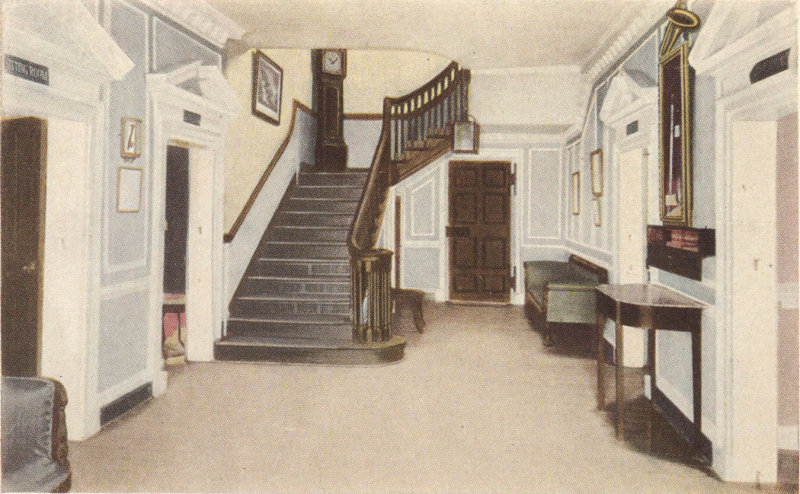
The view of the hall is from the East, showing the main stairway. To the right, doors open into the Music Room and Parlor; to the left are Mrs. Washington’s Sitting Room and the Family Dining Room. The paneling of the hall is as Washington improved it in 1775, and the original colors are restored. The pattern of wall paper above the stairs has been worked out from recently discovered fragments of what was originally there. The key of the Bastile, presented to Washington by Lafayette, in 1789, hangs in a glass case between the doors on the left, while opposite may be seen the brass hunting horn received from the same friend.
Four of Washington’s swords are shown: one he used during the Braddock campaign; his dress sword (damaged by rust); a sword made for him at the Solingen Armory in Prussia; the silver-mounted blade he wore when resigning command of the army (1783) and at his inauguration in 1789. In the case with the swords is the sash worn by General Braddock when he was wounded, and given by him to Col. George Washington, who was then his aide-de-camp.
By his will, Washington bequeathed to each of his nephews one of his five swords, with the following injunction: “Not to unsheathe them for the purpose of shedding blood except it be in self-defence or in the defence of their country and its rights, and in the latter case to keep them unsheathed and prefer falling with them in their hands to the relinquishment thereof.”

The clock on the stairs belonged to Lawrence Washington, the founder of Mount Vernon, and the hall lantern was given to him (1745) by Admiral Vernon, for whom the estate was named.
The marble top table belonged to Washington, and the engravings are reprints of originals. The restoration of the hall is due to the Vice-Regents for Michigan and Alabama.
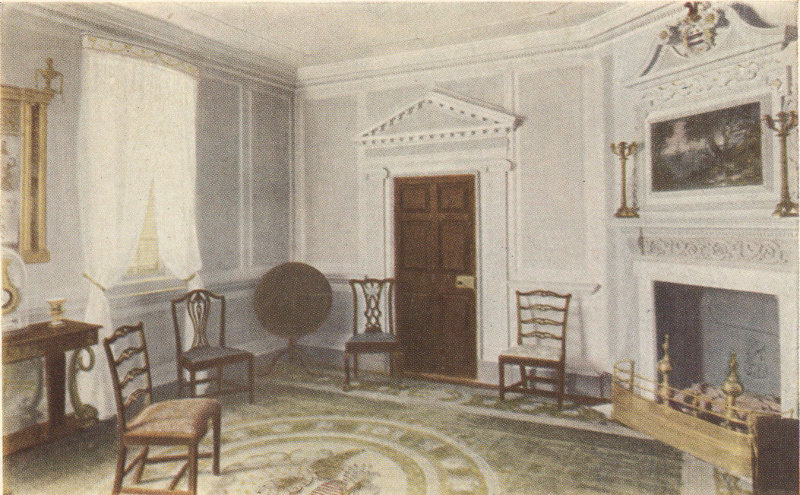
The finish of this room—its wall panels, mantel and ceiling decoration—is a restoration of the original. Washington’s coat of arms is carved above the mantel, and his crest and initials are cast in the heavy fireback. An old painting empaneled over the mantel is said to represent a part of Admiral Vernon’s fleet at Cartagena, and was sent by the Admiral to Lawrence Washington in 1743 as an acknowledgment of Washington’s courtesy in naming the estate for him.
The rug in the room is particularly interesting. It was woven by order of Louis XVI, and sent by him as a present to General Washington.
The curtain cornices are original, also the mirror, now restored to its former position between the windows, and two rosewood stands for vases of flowers.

Key of the Bastile
Among articles of interest gathered by Mrs. Mary T. Leiter, late Vice-Regent for Illinois, are several of the old chairs and a reprint of an engraving of Louis XVI.
The old piano and handsome French clock are contemporaneous but did not belong to the Washingtons.
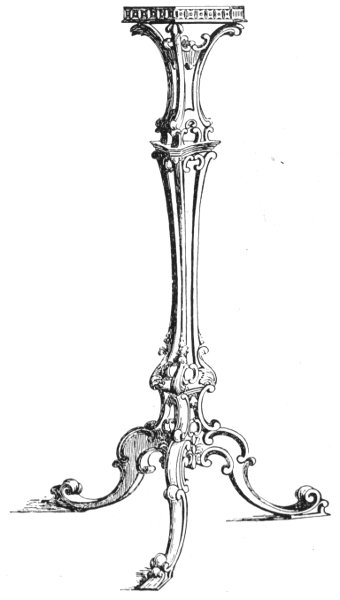
Tripod stand
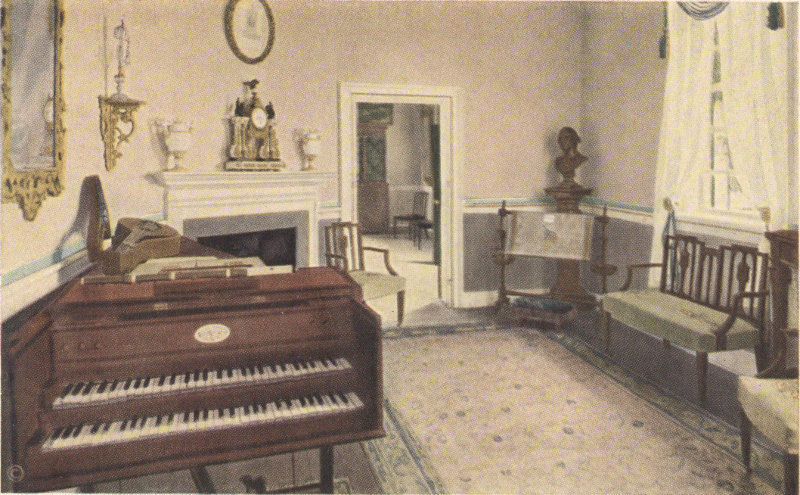
The prominent feature here is the harpsichord which General Washington presented to Nellie Custis. The stool belonged to Nellie Custis. There is also some of her embroidery on an old tambour frame. Here may be seen Washington’s flute, and two of his chairs; also a citra, or guitar, and a card table, which belonged to relatives of Washington. A quaint old music book has been found, bearing the autograph of Martha Parke Custis, the step-daughter of Washington.
This room is in the care of the Vice-Regent for Ohio.

Tambour Frame
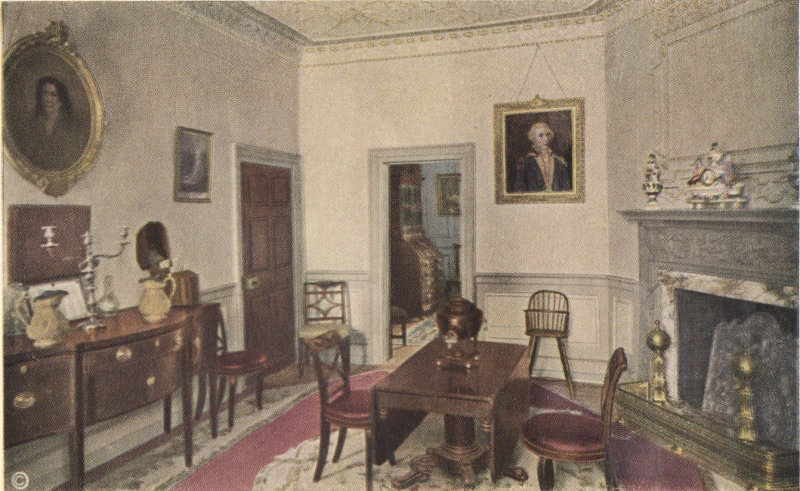
The Vice-Regent for South Carolina has furnished this room. The Heppelwhite sideboard is original. All the furniture is of ancient form. The rug is of the Washington period, as are also the handsome brass andirons and fender. In the corner cupboard may be seen a reproduction of the set of china presented to Mrs. Washington by the officers of the French fleet. The stucco ornamentation of the ceiling is the same as applied in 1775. An iron fireback bearing the Fairfax coat of arms, stands in the fireplace. It was at the Fairfax home, “Belvoir,” adjoining Mount Vernon. The clock and rose jars were Lafayette’s.

A pair of handsome pitchers, Washington’s wine chest, two wine decanters and glass, all of which are authentic, have been lately added, also a chair Washington owned at Cambridge.
Here also is a portrait of David Rittenhouse, which he presented to Washington.
The memorial tablet to Miss Cunningham, of South Carolina, founder of the Mount Vernon Ladies’ Association, has been appropriately given place here with her portrait.
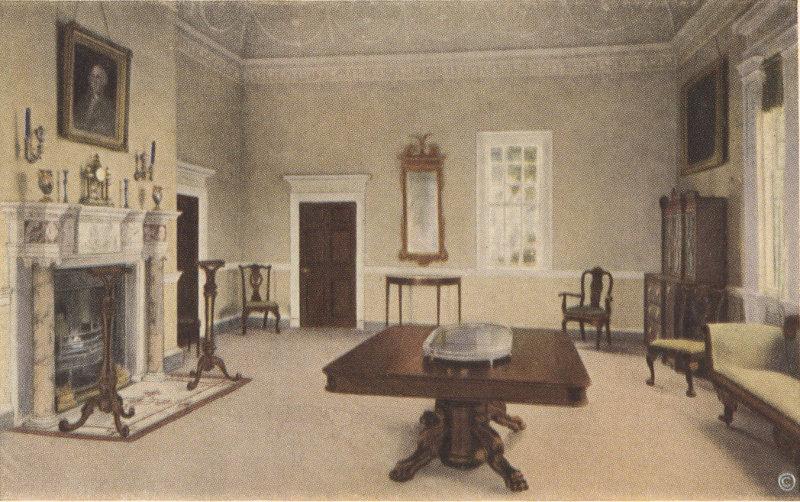
This well-proportioned room was planned by Washington for the banquet hall, and this addition, in 1776, completed the enlargement of his house—now dignified by the name of Mansion. The decoration throughout is as he designed it; the present fresh appearance of which is the result of restorations (1884) by Mrs. Justine Van Renssalaer Townsend, then Vice-Regent for New York. An attractive feature is the handsome marble mantel presented to Washington in 1785 by an English admirer, Mr. Samuel Vaughan. The model of the Bastile is made from a stone from the renowned French prison and was sent over by Lafayette in 1793. A plateau for ornamenting his dining table was imported by Washington. Among original relics recovered for this room are the clock, candlesticks and vases, two quaint silver bracket lamps, a footstool from Washington’s pew in Old Trinity Church, N. Y., and paintings of the Great Falls of the Potomac. There are portraits of Washington by Gilbert Stuart and C. W. Peale, also a supposed portrait of Washington at the age of twenty-one, recently sent over from Glasgow as a loan.

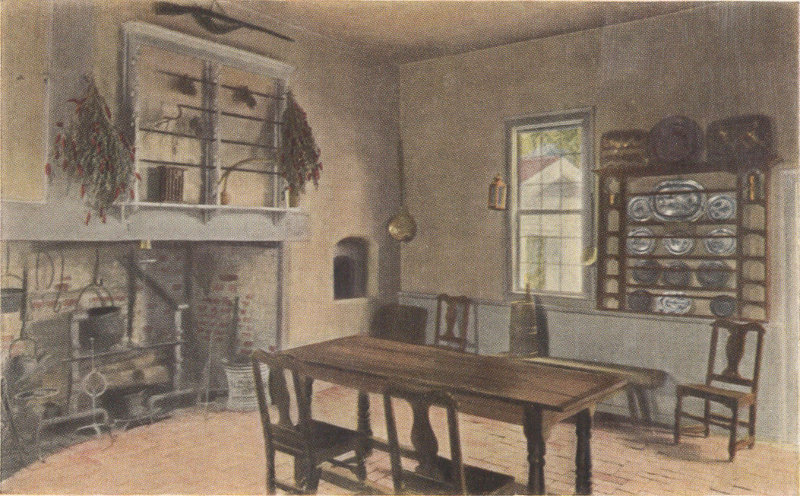
A tour of inspection among the several buildings develops points of interest at every turn. The family kitchen bears evidence, in the proportions of its huge fireplace with ponderous crane and bake-oven near by, of what feasts were prepared therein. The interior of this room was renovated by Miss Amy Townsend, late Vice-Regent for New York, who obtained for it furnishings of contemporaneous date. The smoke-house stood near, and in season was filled with hams and meats for smoking. The larder was well stocked, tradition states, as indeed it must have been, to feed so many guests in addition to the regular household and large retinue of servants.
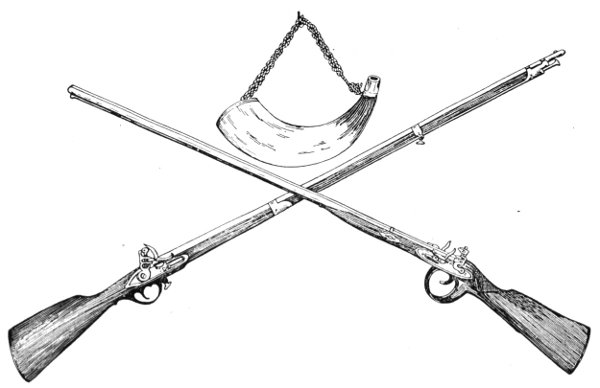
Powder Horn used by one of the “Minute Men” at the Battle of Concord
Charleville Musket brought by General Lafayette in 1777
Shot Gun sometime used by General Washington
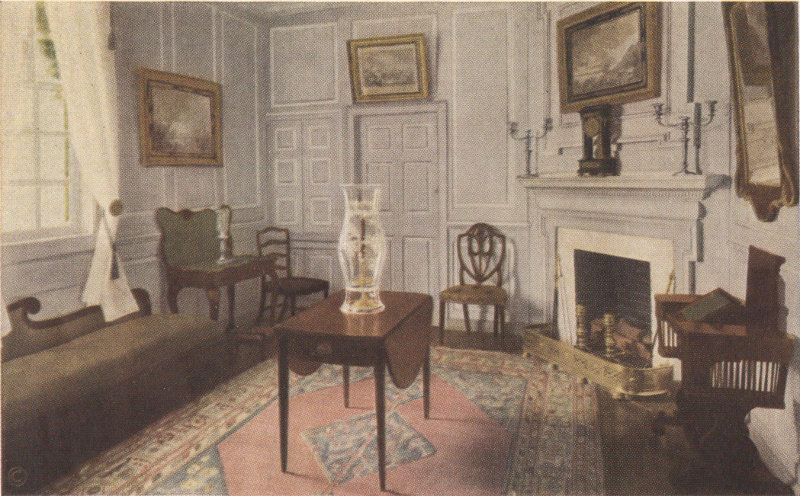
The sitting room is in the care of the Vice-Regent for Georgia. The card table and mirror are original Washington articles of considerable interest. The silver candlestick was owned by Col. William Washington, a nephew of the General. It was presented by Mrs. Georgia Page Wilder, late Vice-Regent for Georgia. The four prints representing the siege of Gibraltar are those which hung at Mount Vernon in the days of Washington. The window curtains and hangings are of the type of that period. A mahogany chair, presented to Washington by Lafayette, is a recent acquisition. One of the candles moulded for the illumination of Yorktown in 1776 is a relic of unique character. A couch which once belonged to Nellie Custis has recently been added.

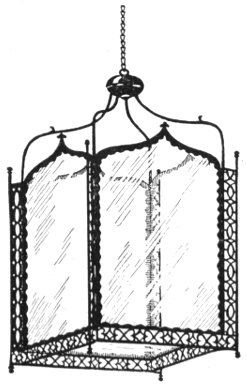


This is one of the rooms General Washington added. It was designed for his study, as shown by the old book shelves built in the wall. Back of opposite doors were shelf rooms for his maps and manuscripts. The bulk of Washington’s library he bequeathed to Judge Bushrod Washington, from whose nephews the books were purchased by a syndicate (1848) and deposited in the Boston Athenæum, where they still are. Some scattered volumes recovered by the Mount Vernon Ladies’ Association include several bearing the genuine signature of George Washington. The names of his mother and members of his family appear upon others. An ancient Bible presented to Washington by the Bishop of Sodor and Man, together with twenty volumes of French History of Travel, sent him by Rochambeau, besides many duplicates of Washington’s books, give interesting character to the present collection. Mrs. Washington’s Prayer Book, and a Family Bible with record of George Washington’s birth and baptism, have lately been acquired.
The “tambour desk” and chair, which Washington used in this room, and left by his will to Dr. Craik, were purchased and restored to Mount Vernon in 1905.
An original mahogany bookcase and a globe are valued relics. The pictures, tambour desk and articles of old-fashioned furniture have been assembled by the Vice-Regent for Massachusetts.
A map of Mount Vernon, and of one of Washington’s plantations, carefully platted by himself, are to be seen here, likewise “rubbings” of brasses on tombs of the Washingtons in England.
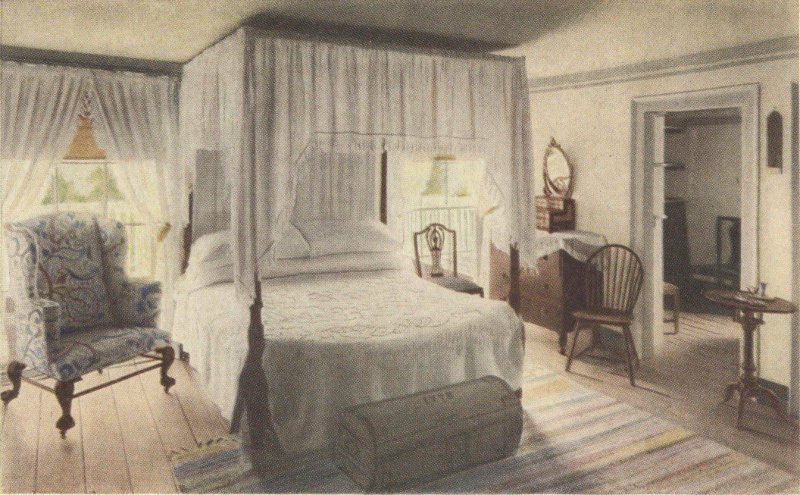
The room in which Washington died (December 14, 1799) deservedly attracts special notice. The items of original furniture and personal effects assembled here add much to the impressive character. A piece associated with Washington’s childhood is his mother’s arm chair. Washington’s bureau, washstand, mirror, etc., are shown. Most prominent of all is the bedstead on which the great and good man breathed his last.
The mahogany shaving stand presented to Washington by the first French minister to this country was recently recovered.
Washington’s crest and initials are wrought in the old fireback. Above the mantel hangs an engraving, one of a set of five entitled “Sorrows of Werther,” which belonged to the General. The arm chair at the foot of the bed was used in this room when Washington died.
The two small rooms connecting with the bed-chamber were used respectively as linen closet and dressing room. Between the doors of these rooms now hangs the frame of Washington’s thermometer.
To the efforts of the late Mrs. Emma Reed Ball, for 44 years the Vice-Regent for Virginia, is due, in great measure, the restoration of this room.


The only room on the third floor historically interesting is the one in which Mrs. Washington died. It must be explained that, following a custom then prevalent, Washington’s room was closed after his death, and his widow selected this attic room because from its only window she could see the tomb where her husband’s body lay. Mrs. Washington died here, May 22, 1802.
Until recently, the only original relics in this room were the washstand presented by Mrs. Martha Mitchell, late Vice-Regent for Wisconsin, and dressing glass presented by Mrs. George R. Goldsborough, late Vice-Regent for Maryland. Now have been added a tea set owned by Mrs. Washington, a christening bowl which belonged to Mrs. Washington’s family—the Dandriges—and an old bed quilt believed to have been used at Mount Vernon.
The care of this room fell to the Vice-Regent for Wisconsin.

Ascending by the stairway, from the main hall to the second floor, six bedrooms are found—the Lafayette Room, River Room, Guest Chamber, Nellie Custis Room, Green Room and Mrs. Washington’s Room. These are in charge of the Vice-Regents representing, respectively, the following States: New Jersey, Pennsylvania, Delaware, Maryland, West Virginia and Virginia. The first five rooms contain but little original furniture, although all the articles are of historic importance and represent the correct type of the Colonial period.
In the Nellie Custis Room are a table cover and footstool embroidered by her.
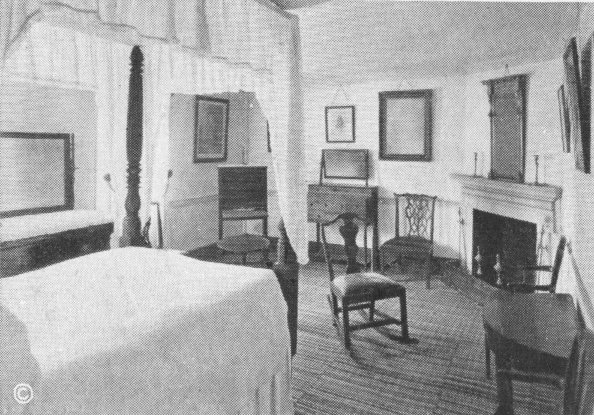
LAFAYETTE ROOM

RIVER ROOM

GUEST ROOM

GREEN ROOM
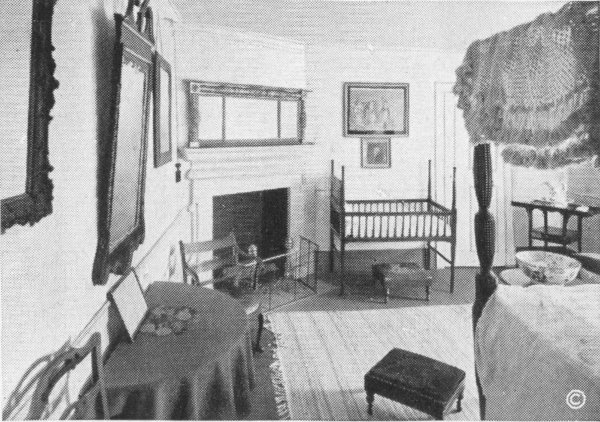
NELLIE CUSTIS ROOM
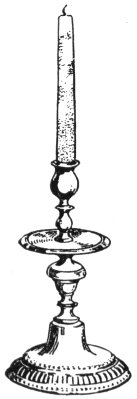
The four spare rooms on this floor are furnished appropriately after the old style, by the Vice-Regents for District of Columbia, Connecticut, North Carolina and Maine. Formerly the Washingtons found these rooms useful as spare chambers for the accommodation of guests. The good old custom of keeping “open house” attracted to Mount Vernon hosts of their friends traveling North and South, and doubtless the Mansion was often taxed to its fullest capacity.
In the linen room on this floor may be seen Washington’s military chest, and camp equipments used by his troops when serving with General Braddock.
One of the chairs in the room furnished by Mrs. Mary T. Barnes, the late Vice-Regent for District of Columbia, belonged to Washington.
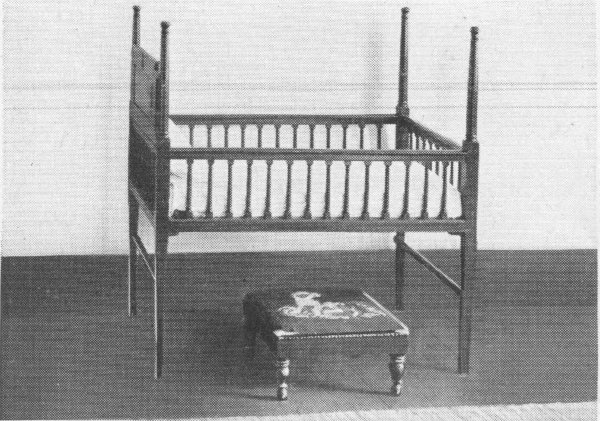
FOOTSTOOL—CRIB IN NELLIE CUSTIS ROOM
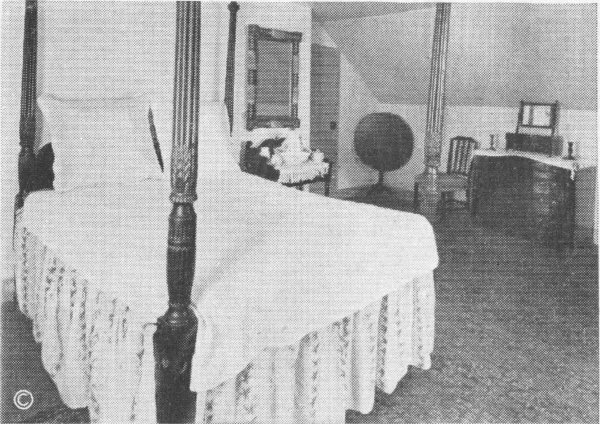
SPARE ROOM
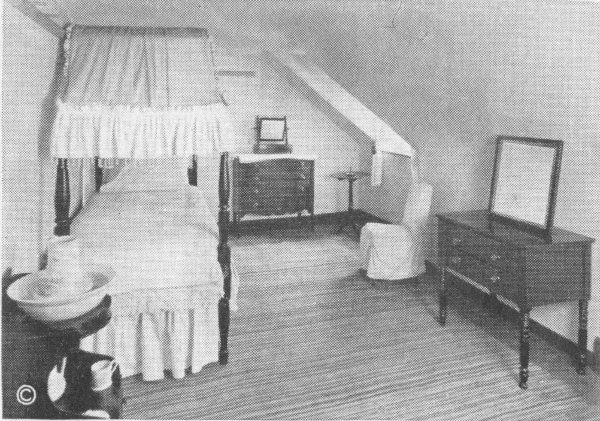
SPARE ROOM
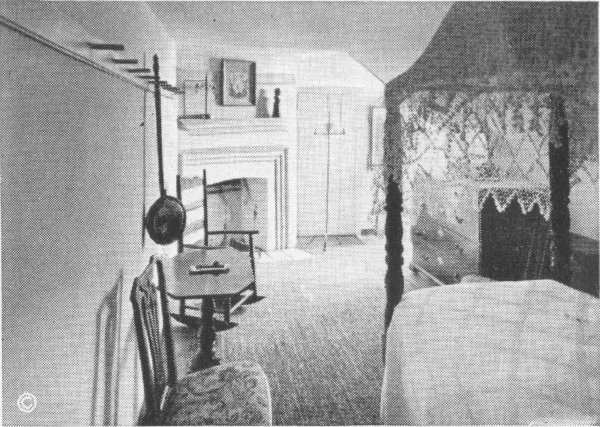
SPARE ROOM
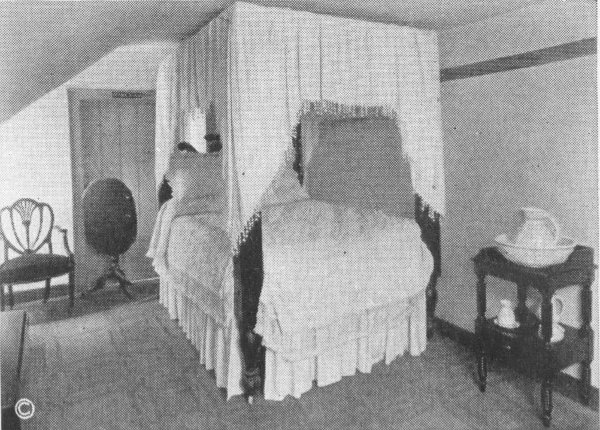
SPARE ROOM

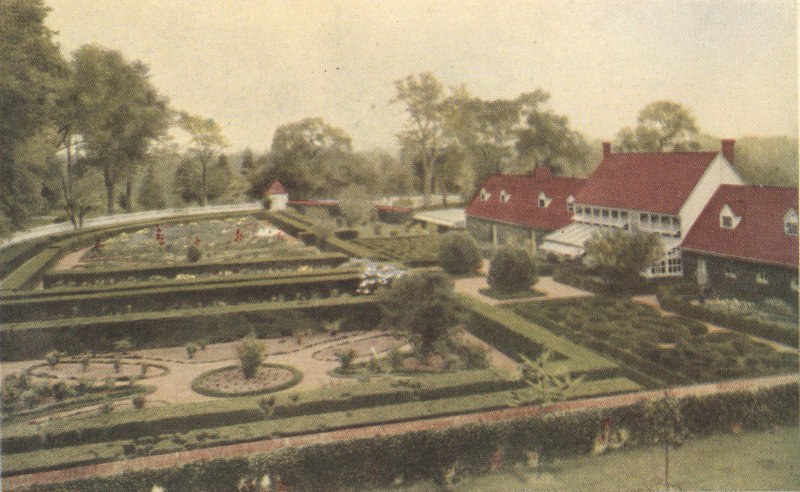
Among all of the charms and attractions of the home of Washington, not one can excel the beautiful flower garden—an ideal spot—with its memories of General and Lady Washington who planned it, the prim box hedges indelibly marking the walks and flower beds now as in the past. Distinguished guests were invited to plant trees, shrubs and flowers, mementos of their visits, many of which plantings have been perpetuated. Lafayette and Jefferson have leafy monuments here, while the roses named by Washington for his mother and Nellie Custis are daily sought by pilgrims.
At the end of the long walk in the garden is a little octagonal structure known as the school room, in which it is supposed the Custis children were taught their early lessons.
The greenhouse restorations are due to the efforts of Mrs. Martha Mitchell, Mrs. Lucy H. Pickens and Miss Mary Lloyd Pendleton, late Vice-Regents, respectively, for Wisconsin, South Carolina and Ohio.
Two long, red-roofed buildings adjoin the conservatory. These were the quarters for a limited number of servants needed at the Mansion. Comfortable cabins to house the rest of the negroes were located at convenient distances about the plantation. Both these quarters were in ruins, but have been restored—the West Quarters by Mrs. Jennie Meeker Ward, late Vice-Regent for Kansas in 1890, and the East Quarters by Miss Amy Townsend, late Vice-Regent for New York in 1897. While in exterior form these buildings are identical with their original appearance, the interior of each has been somewhat changed to meet existing requirements.

George Washington’s fondness for experimental gardening is shown by the care with which he arranged these terraced beds for growing small fruits and vegetables for the use of his household. His diary is evidence enough of the eagerness with which he selected the best-known seed and exploited, with more or less success, the latest improvements in horticulture.
Sheltered by the walls he built, scions of original fig bushes still flourish, while bordering the cross walk to the gate, the box hedge he planted has developed to unusual proportions.
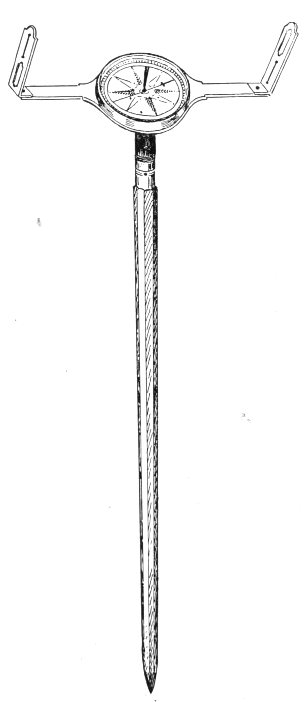
Compass
Spy Glass

Tripod
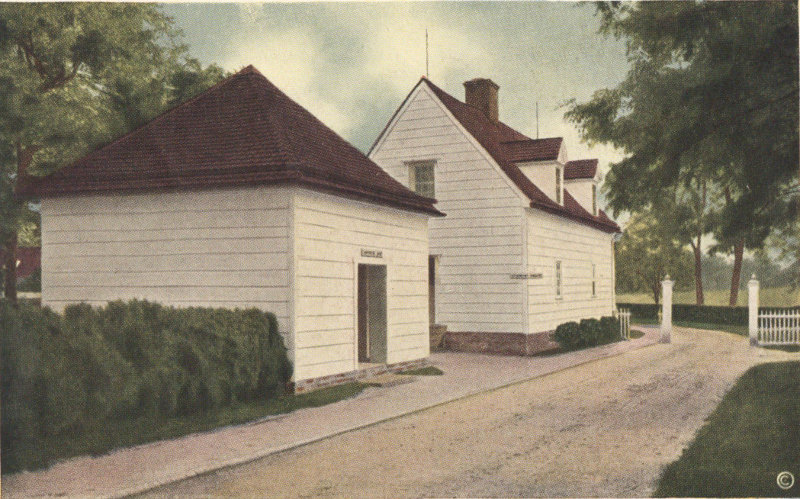
In Washington’s day this building was the center of much activity, it being the all-essential tool-shop for general repairs.
In outward appearance its original character and purpose are still preserved.
Its interior arrangement, however, has been altered to meet the urgent need of a fireproof repository for valuable records of the Association.
The spinning house, north of the court, is where much material was prepared for clothing the servants, and where rag carpets and other fabrics were woven for the use of the family. Flax, cotton, wool and silk were there put through the various processes of spinning and weaving by skilled servants. The old loom, wheels, reels, and flaxbrake were recovered by Mrs. Rebecca B. Flandrau, late Vice-Regent for Minnesota, 1892.
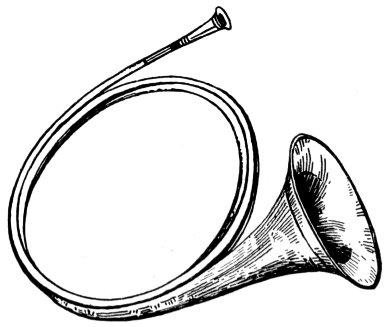
Hunting Horn
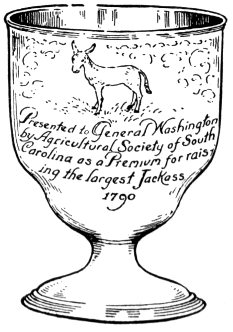
Presented to General Washington
by Agricultural Society of South
Carolina as a Premium for raising the largest Jackass
1790
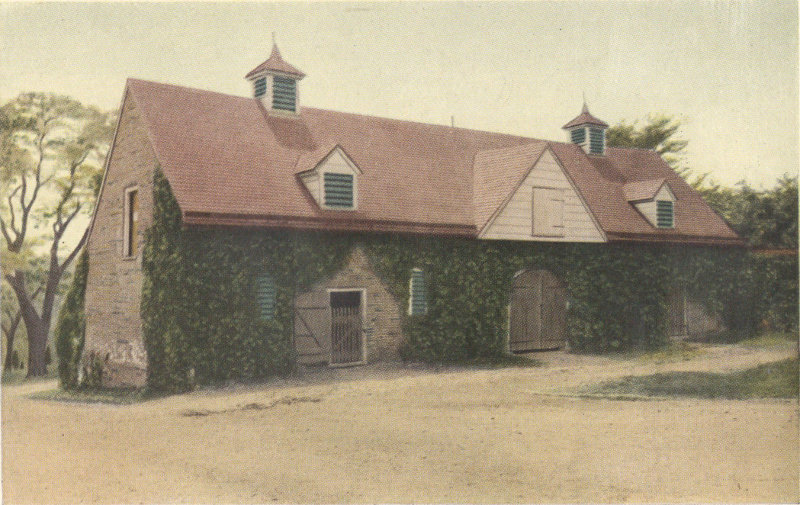
The oldest building here is the barn, erected in 1733 by Washington’s father. The bricks are said to have been brought from England, and they were laid in strong mortar made of oyster-shell lime. The shingle roof of this building was renewed in 1874, the cost being shared by all the members of the Association. Substantial renovations of the interior were effected in 1896-7 by Mrs. William Ames, the late Vice-Regent for Rhode Island.
Here were stabled the coach horses and saddle horses. Washington’s famous traveling coach, the “White Chariot,” as he called it, was kept in the coach house near by. This coach house was restored in 1894 by the Vice-Regent for Michigan, who was also instrumental in obtaining (1901) the ancient vehicle now here, a duplicate of the original carriage owned by Washington. From well-founded tradition it is believed that General and Mrs. Washington frequently rode in this coach.

WAGON JACK MADE IN 1764 BY PETER MOHR
YORK, PA.
USED IN REPAIRING WASHINGTON’S CARRIAGES AT MT. VERNON
An original feature restored as Washington had it, was a “Ha Ha” wall extending from opposite the barn to the summer house, also a screen wall flanking the road from the barn to the kitchen.
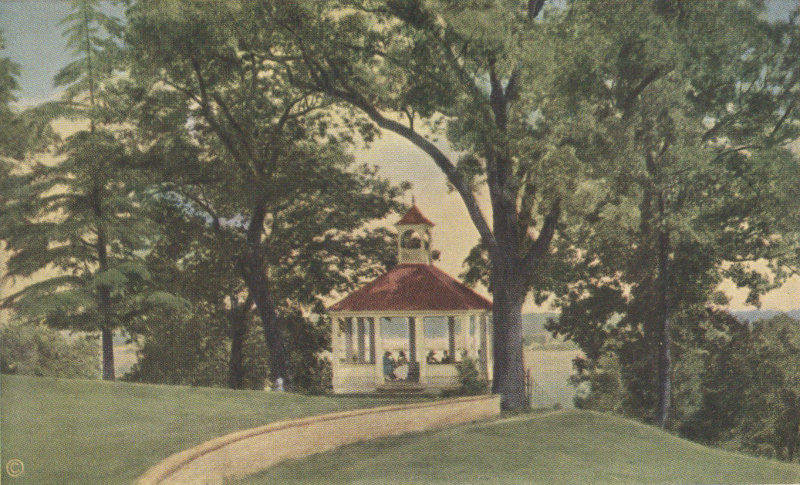
On the brow of the steep hillside, south of the Mansion, overlooking the river, is the summer house. It commands a beautiful view of the broad Potomac, with the Maryland hills beyond, and doubtless was a favorite resort in “ye olden time.” It was restored in 1886, the funds being raised by the Vice-Regent for Louisiana, Mrs. Ida A. Richardson, through the school children of her State. The deep cellar under the summer house was intended for an ice house, but it is believed to have been abandoned as such when another was constructed in a more convenient locality north of the Mansion.
The wooded slope below the summer house was utilized by Washington for his deer paddock, which was restored and stocked with Virginia deer, in 1887, by the sons of the late Mrs. Robert Campbell, Vice-Regent for Missouri.
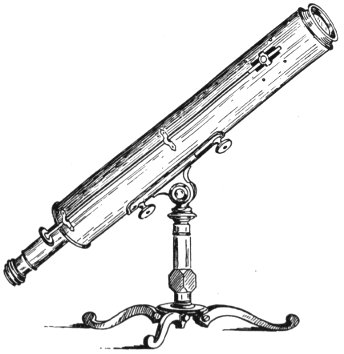
Telescope
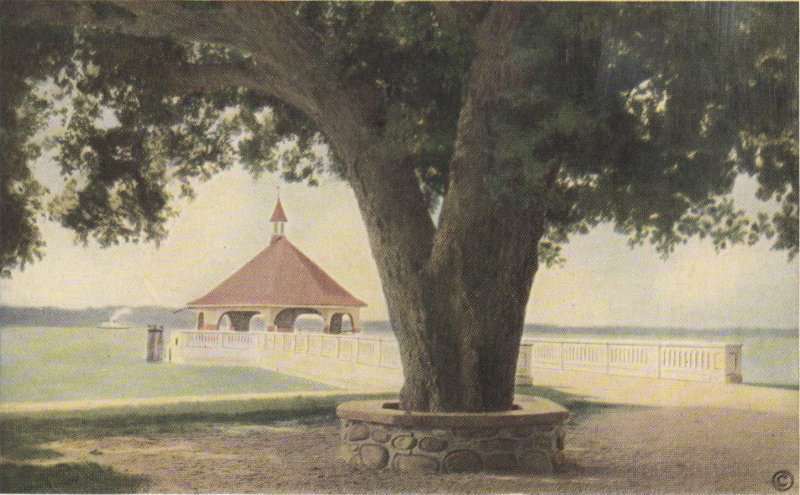
Washington shipped much of his farm produce and supplies by water—and today are landed at the wharf many pilgrims to the home and tomb of the “Father of His Country.” The custom of tolling a bell as a mark of respect to his memory is hallowed by its observance for more than a century.
The present covering of the wharf was provided in 1891 by Mrs. Phoebe A. Hearst, late Vice-Regent for California. The parapet for protection of the public was given by the Vice-Regent for the State of Washington, and the Iron Gates by the Vice-Regent for Oregon.
Mrs. Hearst also caused to be built the substantial stone sea-wall as a necessary protection to the wooded shore against wave-wash during storms. This important improvement has enabled the Association to complete the filling of neighboring ravines and swamps, thus accomplishing a valuable reclamation now utilized as meadow land.
From the wharf a road and walk lead to the Tomb and Mansion.

Land Barometer

Ship Barometer

On the edge of the hill, midway down the road leading to the wharf, an iron-railed enclosure marks where Washington’s remains rested from 1799 until 1831. This vault was constructed by George Washington, but later, believing it to be insecure, he planned another tomb, which his executors built. In April, 1831, all bodies in the old vault were transferred to the new tomb.
The cause of apprehension as to safety of the old structure, resulting in its abandonment, was the frequency of landslides near it.
Extensive repairs to the old tomb were made in 1887 by the Vice-Regent for Michigan. The iron railing was found necessary for protection.
In 1908 the broad flight of brick steps was completely rebuilt, the original material, suitable for the purpose, being used again.
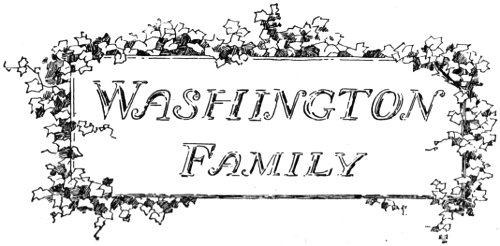
Washington Family
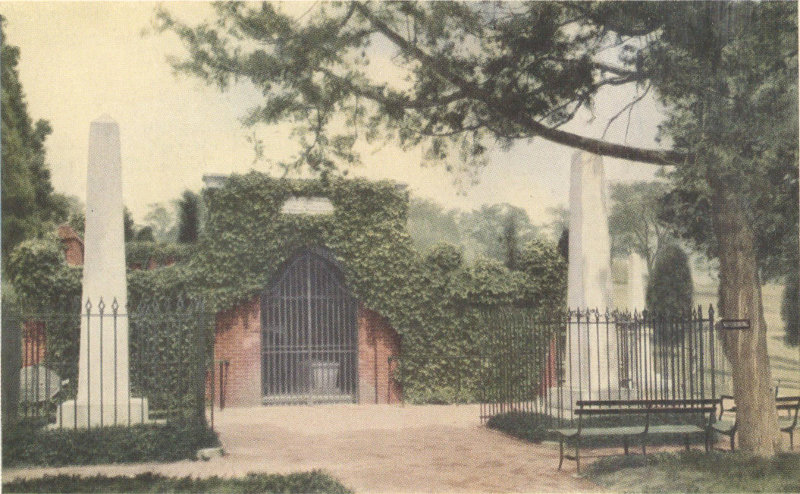
This plain statement empaneled above the doorway of the rigidly simple brick vault at once marks its importance. Within the doubly ironed portals may be seen two marble sarcophagi; that on the right contains the body of General Washington and the one on the left the remains of his wife. At the rear of this open vault, and connected with it through a square iron door, is an inner vault containing the remains of many of the Washington family. To the memory of Bushrod Washington and John Augustine Washington, successors of the General (whose bodies are within the vault), marble shafts were erected in front of the tomb, while to the east are the graves of Nellie Custis and her daughter.
Washington selected this site for the vault only a few months before he died. His executors carried out his explicit directions as to construction, which accounts for its extreme simplicity. Because of Washington’s distaste for display, the character of this tomb should never be changed. Extensive repairs for the preservation of the original structure were made by the Association in 1886. To this hallowed spot come pilgrims from every land.

Within this Enclosure Rest the remains of Genl George Washington.
| MISS ANN PAMELA CUNNINGHAM, Regent, 1853-1873 | |||||
|---|---|---|---|---|---|
| (Resigned, 1873; Died, May 1, 1875) | |||||
| Vice-Regents | |||||
| 1858— | 1 | Mrs. Anna Cora Ogden Ritchie | resigned | 1866 | Virginia |
| 2 | Mrs. Alice H. Dickinson | resigned | 1859 | North Carolina | |
| 3 | Mrs. Philoclea Edgeworth Eve | died | 1889 | Georgia | |
| 4 | Mrs. Octavia Walton Levert | died | 1877 | Alabama | |
| 5 | Mrs. Catharine A. McWillie | died | 1872 | Mississippi | |
| 6 | Mrs. Margaretta S. Morse | resigned | 1872 | Louisiana | |
| 7 | Mrs. Mary Rutledge Fogg | died | 1872 | Tennessee | |
| 8 | Mrs. Elizabeth M. Walton | resigned | 1858 | Missouri | |
| 9 | Miss Mary Morris Hamilton | resigned | 1866 | New York | |
| 10 | Mrs. Louisa Ingersoll Greenough | resigned | 1865 | Massachusetts | |
| 11 | Mrs. Abba Isabella Little | resigned | 1866 | Maine | |
| 12 | Mrs. Catherine Willis Murat | died | 1867 | Florida | |
| 13 | Mrs. Mary Booth Goodrich | resigned | 1864 | Connecticut | |
| 14 | Miss Phœbe Ann Ogden | died | 1867 | New Jersey | |
| 15 | Mrs. Alice Key Pendleton | resigned | 1863 | ||
| died | 1885 | Ohio | |||
| 16 | Mrs. Abby Wheaton Chace | died | 1892 | Rhode Island | |
| 17 | Mrs. Jane Maria van Antwerp | died | 1870 | Iowa | |
| 18 | Mrs. Margaret Ann Comegys | died | 1888 | Delaware | |
| 19 | Mrs. Hannah Blake Farnsworth | died | 1879 | Michigan | |
| 20 | Mrs. Sarah King Hale | resigned | 1861 | New Hampshire | |
| 21 | Mrs. Martha Mitchell | died | 1902 | Wisconsin | |
| 22 | Mrs. Rosa Vertner Johnson Jeffries | died | 1894 | Kentucky | |
| Mrs. Janet M. C. Riggs, Acting Vice-Regent | District of Columbia | ||||
| 1859— | 23 | Mrs. Elizabeth Willard Barry | died | 1883 | Illinois |
| 24 | Mrs. Sarah J. Sibley | died | 1869 | Minnesota | |
| 25 | Mrs. Mary Pepperell Jarvis Cutts | resigned | 1878 | Vermont | |
| 26 | Miss Lily Lytle Macalester | died | 1891 | Pennsylvania | |
| 27 | Mrs. Magdalen G. Blanding | resigned | 1884 | California | |
| 28 | Mrs. Harriet B. Fitch | died | 1880 | Indiana | |
| 29 | Mrs. Sarah H. Johnson | died | 1866 | Arkansas | |
| 30 | Mrs. Letitia Harper Walker | died | 1908 | North Carolina | |
| 1860— | 31 | Mrs. Ann Lucas Hunt | died | 1878 | Missouri |
| 32 | Mrs. Mary Chesnut | died | 1867 | South Carolina | |
| 1866— | 33 | Mrs. Margaret J. M. Sweat | died | 1908 | Maine |
| 34 | Miss Emily L. Harper | died | 1891 | Maryland | |
| 35 | Mrs. Lucy H. Pickens | died | 1899 | North Carolina | |
| 36 | Mrs. M. E. Hickman | resigned | 1874 | Nevada | |
| 37 | Mrs. M. A. Stearns | resigned | 1873 | New Hampshire | |
| 38 | Mrs. Emily R. M. Hewson | resigned | 1872 | Ohio | |
| 39 | Miss Ella Hutchins | resigned | 1872 | Texas | |
| 1867— | 40 | Mrs. Janet M. C. Riggs | resigned | 1868 | |
| died | 1871 | District of Columbia | |||
| 41 | Mrs. Maria Brooks | resigned | 1876 | New York | |
| 42 | Mrs. Matilda W. Emory | resigned | 1873 | District of Columbia | |
| 1868— | 43 | Mrs. Nancy Wade Halsted | died | 1891 | New Jersey |
| 44 | Mrs. Nannie C. Yulee | died | 1884 | Florida | |
| 1870— | 45 | Mrs. Susan E. Johnson Hudson | died | 1913 | Connecticut |
| 46 | Mrs. Ella Bassett Washington | died | 1898 | West Virginia | |
| 1872— | 47 | Mrs. Betsy C. Mason | died | 1873 | Virginia |
| 48 | Mrs. A. P. Dillon | resigned | 1873 | ||
| died | 1898 | Iowa | |||
| 49 | Mrs. C. L. Scott | resigned | 1878 | Arkansas | |
| 1873— | 50 | Mrs. William Balfour | resigned | 1875 | Mississippi |
| 51 | Mrs. Mary T. Barnes | died | 1912 | District of Columbia | |
| 52 | Mrs. David Urquehart | resigned | 1876 | Louisiana | |
| 53 | Miss M. E. Maverick | resigned | 1873 | Texas | |
| MRS. LILY LYTLE MACALESTER BERGHMAN, Second Regent | |||||
| (Made Acting Regent, 1873; Regent, June, 1874; Died, 1891) | |||||
| 1874— | 54 | Mrs. Emma Read Ball | died | 1918 | Virginia |
| 55 | Mrs. Aaron V. Brown | died | 1889 | Tennessee | |
| 1875— | 56 | Mrs. Elizabeth Lytle Broadwell | died | 1890 | Ohio |
| 57 | Mrs. John P. Jones | resigned | 1876 | Nevada | |
| 1876— | 58 | Mrs. Jennie Meeker Ward | died | 1910 | Kansas |
| 59 | Mrs. Justine van Rensselaer Townsend | died | 1912 | New York | |
| 1878— | 60 | Mrs. J. Gregory Smith | resigned | 1884 | Vermont |
| 1879— | 61 | Miss Alice M. Longfellow | Massachusetts | ||
| 62 | Mrs. Robert Campbell | died | 1882 | Missouri | |
| 1880— | 63 | Mrs. Ida A. Richardson | died | 1910 | Louisiana |
| 1882— | 64 | Mrs. Ella S. Herbert | died | 1884 | Alabama |
| Vice-Regents | |||||
| 1885— | 65 | Mrs. Elizabeth B. Adams Rathbone | resigned | 1919 | |
| died | 1923 | Michigan | |||
| 66 | Mrs. Mary T. Leiter | died | 1913 | Illinois | |
| 67 | Mrs. Janet de Kay King | died | 1896 | Vermont | |
| 68 | Mrs. Elizabeth Woodward | died | 1987 | Kentucky | |
| 1888— | 69 | Miss Harriet Clayton Comegys | Elected Regent | 1909 | Delaware |
| 70 | Mrs. Fannie Gilchrist Baker | died | 1901 | Florida | |
| 1889— | 71 | Mrs. Alice Hill | died | 1908 | Colorado |
| 72 | Mrs. Rebecca B. Flandrau | died | 1912 | Minnesota | |
| 73 | Mrs. Phœbe A. Hearst | died | 1919 | California | |
| 1890— | 74 | Mrs. A. R. Winder | died | 1906 | New Hampshire |
| 1891— | 75 | Mrs. Georgia Page Wilder | died | 1914 | Georgia |
| MRS. JUSTINE Van RENSSELAER TOWNSEND, Third Regent | |||||
| (Elected Temporary Regent, December, 1891; Regent, June, 1892; Died, 1912) | |||||
| 1893— | 76 | Mrs. Geo. R. Goldsborough | resigned | 1904 | |
| died | 1906 | Maryland | |||
| 77 | Mrs. J. Dundas Lippincott | died | 1894 | Pennsylvania | |
| 78 | Miss Mary Lloyd Pendleton | resigned | 1897 | Ohio | |
| 79 | Mrs. Philip Schuyler | resigned | 1894 | New York | |
| 80 | Mrs. Christine Blair Graham | died | 1915 | Missouri | |
| 81 | Mrs. Francis Stevens Conover | died | 1914 | New Jersey | |
| 82 | Mrs. Mary Polk Yeatman Webb | died | 1917 | Tennessee | |
| 1894— | 83 | Miss Lelia Herbert | died | 1897 | Alabama |
| 1895— | 84 | Mrs. Robert H. Clarkson | resigned | 1900 | |
| died | 1902 | Nebraska | |||
| 85 | Mrs. William Ames | died | 1904 | Rhode Island | |
| 86 | Miss Amy Townsend | died | 1920 | New York | |
| 1896— | 87 | Mrs. Charles Custis Harrison | died | 1922 | Pennsylvania |
| 88 | Mrs. Thomas S. Maxey | Texas | |||
| 1897— | 89 | Mrs. James E. Campbell | resigned | 1902 | Ohio |
| 1900— | 90 | Mrs. Robert D. Johnston | Alabama | ||
| 91 | Mrs. Charles F. Manderson | died | 1916 | Nebraska | |
| 92 | Mrs. Eugene van Rensselaer | died | 1924 | West Virginia | |
| 1901— | 93 | Mrs. John Julius Pringle | died | 1921 | South Carolina |
| 94 | Mrs. William F. Barret | died | 1920 | Kentucky | |
| 95 | Mrs. Charles Denby | died | 1906 | Indiana | |
| 1905— | 96 | Mrs. Henry W. Rogers | Maryland | ||
| 1907— | 97 | Mrs. Lewis Irwin | died | 1916 | Ohio |
| 98 | Miss Mary F. Failing | Oregon | |||
| 99 | Mrs. Eliza Ferry Leary | Washington | |||
| 100 | Mrs. Frances Jones Ricks | resigned | 1914 | Mississippi | |
| 101 | Mrs. J. Carter Brown | Rhode Island | |||
| 1909— | 102 | Mrs. A. B. Andrews | died | 1915 | North Carolina |
| MISS HARRIET CLAYTON COMEGYS, Fourth Regent | |||||
| (Elected, May, 1909; Resigned, May, 1927; Died, August, 1927) | |||||
| 1911— | 103 | Mrs. Alice H. Richards | Maine | ||
| 104 | Miss Mary Evarts | resigned | 1923 | Vermont | |
| 105 | Mrs. Antoine Lentilhon Foster | Delaware | |||
| 1912— | 106 | Miss Annie Ragan King | Louisiana | ||
| 107 | Miss Jane A. Riggs | District of Columbia | |||
| 1913— | 108 | Mrs. Horace Mann Towner | Iowa | ||
| 109 | Mrs. Thomas Palmer Denham | Florida | |||
| 1914— | 110 | Miss Harriet L. Huntress | died | 1922 | New Hampshire |
| 111 | Mrs. Charles Eliot Furness | Minnesota | |||
| 112 | Mrs. Benjamin D. Walcott | Indiana | |||
| 113 | Mrs. Lucien M. Hanks | Wisconsin | |||
| 1915— | 114 | Miss Annie Burr Jennings | Connecticut | ||
| 115 | Mrs. Willard Hall Bradford | New Jersey | |||
| 1916— | 116 | Mrs. Charles Nagel | Missouri | ||
| 117 | Mrs. George A. Carpenter | Illinois | |||
| 118 | Miss Mary Govan Billups | Mississippi | |||
| 119 | Mrs. John V. Abrahams | resigned | 1921 | Kansas | |
| 1919— | 120 | Mrs. William Ewen Shipp | North Carolina | ||
| 121 | Mrs. Horton Pope | Colorado | |||
| 122 | Mrs. Charles J. Livingood | Ohio | |||
| 123 | Mrs. Jefferson Randolph Anderson | Georgia | |||
| 124 | Mrs. Celsus Price Perrie | resigned | 1922 | Arkansas | |
| 1920— | 125 | Mrs. Horace van Deventer | Tennessee | ||
| 126 | Mrs. Charles Stetson Wheeler | California | |||
| 1921— | 127 | Mrs. William Ruffin Cox | died | 1925 | Virginia |
| 1922— | 128 | Mrs. Henry Gold Danforth | New York | ||
| 1923— | 129 | Miss Mary Mason Scott | Kentucky | ||
| 130 | Mrs. Alexander C. Troup | Nebraska | |||
| 131 | Mrs. John Reynolds Shelton | Kansas | |||
| 132 | Mrs. Edward H. Parker | died | 1924 | Michigan | |
| 1924— | 133 | Miss Mary Evarts | Vermont | ||
| 1924— | 134 | Miss Virginia Leigh Porcher | South Carolina | ||
| 135 | Mrs. William R. Mercer | resigned | 1928 | Pennsylvania | |
| 136 | Miss Constance Lee Peterkin | West Virginia | |||
| 1925— | 137 | Mrs. Benjamin S. Warren | Michigan | ||
| 1927— | 138 | Mrs. Fairfax Harrison | Virginia | ||
| MRS. ALICE H. RICHARDS, Fifth Regent | |||||
| (Elected, May, 1927) | |||||
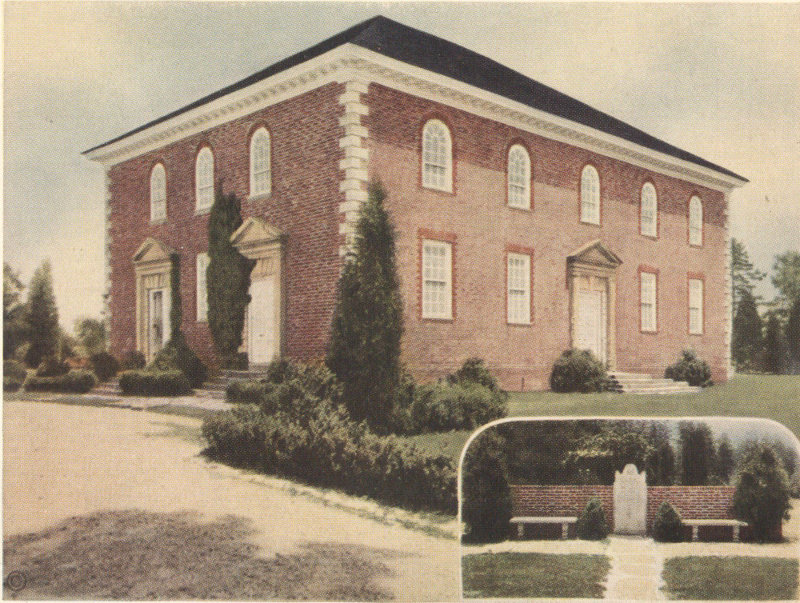
The parish church of Mount Vernon, six miles distant from the Mansion, was built during the years 1768-70 from the plans drawn by General Washington, who was a member of the building committee. He was a vestryman of the parish for twenty years, and for the greater part of that time was a regular attendant at service, never permitting, as Bishop Meade says, “the weather or company to keep him from church.” Subsequently Washington became connected with Christ Church, Alexandria, where today his family pew may be seen as he used it.
Pohick Church, during the Civil War, was occupied at times by Federal troops and all the interior furnishings were destroyed. The late Vice-Regent for Michigan, Mrs. E. B. A. Rathbone, worked untiringly in the interest of the church, and to her are due the large additions to its endowment fund. Through the efforts of Miss Amy Townsend, former Vice-Regent for New York, both interior and exterior have been faithfully restored to their original appearance at the time of Washington.

To The
Unknown Dead
of
Pohick Church
This
Tribute of Respect
is paid the
Many Parishioners
Buried in this Hallowed Churchyard
The Records are Lost & the Graves
Cannot now be Identified
1925
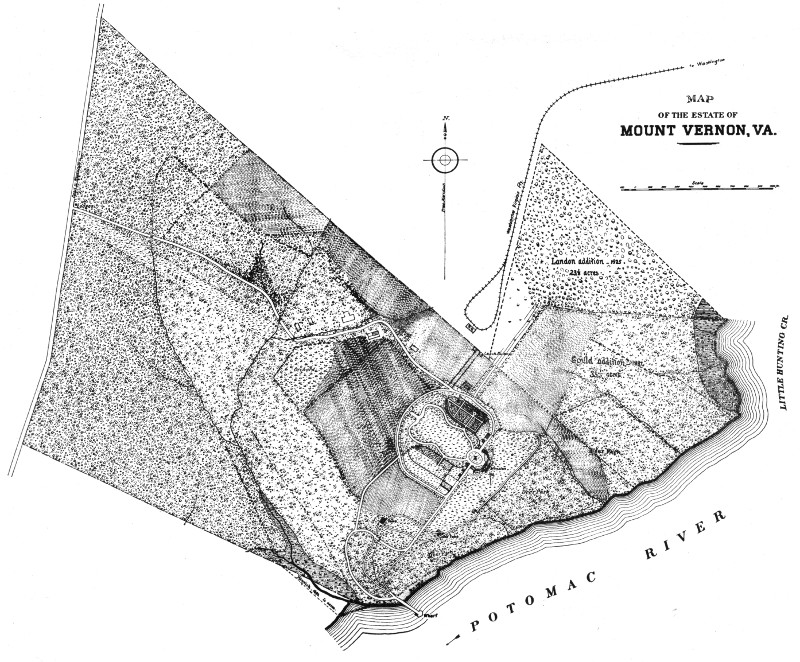
MAP OF THE ESTATE OF MOUNT VERNON, VA.
Photographed, Engraved and Printed by The Beck Engraving Co., Phila.
End of the Project Gutenberg EBook of An Illustrated Handbook of Mount Vernon, by
Mount Vernon Ladies' Association
*** END OF THIS PROJECT GUTENBERG EBOOK ILLUSTRATED HANDBOOK--MOUNT VERNON ***
***** This file should be named 55997-h.htm or 55997-h.zip *****
This and all associated files of various formats will be found in:
http://www.gutenberg.org/5/5/9/9/55997/
Produced by Stephen Hutcheson and the Online Distributed
Proofreading Team at http://www.pgdp.net
Updated editions will replace the previous one--the old editions will
be renamed.
Creating the works from print editions not protected by U.S. copyright
law means that no one owns a United States copyright in these works,
so the Foundation (and you!) can copy and distribute it in the United
States without permission and without paying copyright
royalties. Special rules, set forth in the General Terms of Use part
of this license, apply to copying and distributing Project
Gutenberg-tm electronic works to protect the PROJECT GUTENBERG-tm
concept and trademark. Project Gutenberg is a registered trademark,
and may not be used if you charge for the eBooks, unless you receive
specific permission. If you do not charge anything for copies of this
eBook, complying with the rules is very easy. You may use this eBook
for nearly any purpose such as creation of derivative works, reports,
performances and research. They may be modified and printed and given
away--you may do practically ANYTHING in the United States with eBooks
not protected by U.S. copyright law. Redistribution is subject to the
trademark license, especially commercial redistribution.
START: FULL LICENSE
THE FULL PROJECT GUTENBERG LICENSE
PLEASE READ THIS BEFORE YOU DISTRIBUTE OR USE THIS WORK
To protect the Project Gutenberg-tm mission of promoting the free
distribution of electronic works, by using or distributing this work
(or any other work associated in any way with the phrase "Project
Gutenberg"), you agree to comply with all the terms of the Full
Project Gutenberg-tm License available with this file or online at
www.gutenberg.org/license.
Section 1. General Terms of Use and Redistributing Project
Gutenberg-tm electronic works
1.A. By reading or using any part of this Project Gutenberg-tm
electronic work, you indicate that you have read, understand, agree to
and accept all the terms of this license and intellectual property
(trademark/copyright) agreement. If you do not agree to abide by all
the terms of this agreement, you must cease using and return or
destroy all copies of Project Gutenberg-tm electronic works in your
possession. If you paid a fee for obtaining a copy of or access to a
Project Gutenberg-tm electronic work and you do not agree to be bound
by the terms of this agreement, you may obtain a refund from the
person or entity to whom you paid the fee as set forth in paragraph
1.E.8.
1.B. "Project Gutenberg" is a registered trademark. It may only be
used on or associated in any way with an electronic work by people who
agree to be bound by the terms of this agreement. There are a few
things that you can do with most Project Gutenberg-tm electronic works
even without complying with the full terms of this agreement. See
paragraph 1.C below. There are a lot of things you can do with Project
Gutenberg-tm electronic works if you follow the terms of this
agreement and help preserve free future access to Project Gutenberg-tm
electronic works. See paragraph 1.E below.
1.C. The Project Gutenberg Literary Archive Foundation ("the
Foundation" or PGLAF), owns a compilation copyright in the collection
of Project Gutenberg-tm electronic works. Nearly all the individual
works in the collection are in the public domain in the United
States. If an individual work is unprotected by copyright law in the
United States and you are located in the United States, we do not
claim a right to prevent you from copying, distributing, performing,
displaying or creating derivative works based on the work as long as
all references to Project Gutenberg are removed. Of course, we hope
that you will support the Project Gutenberg-tm mission of promoting
free access to electronic works by freely sharing Project Gutenberg-tm
works in compliance with the terms of this agreement for keeping the
Project Gutenberg-tm name associated with the work. You can easily
comply with the terms of this agreement by keeping this work in the
same format with its attached full Project Gutenberg-tm License when
you share it without charge with others.
1.D. The copyright laws of the place where you are located also govern
what you can do with this work. Copyright laws in most countries are
in a constant state of change. If you are outside the United States,
check the laws of your country in addition to the terms of this
agreement before downloading, copying, displaying, performing,
distributing or creating derivative works based on this work or any
other Project Gutenberg-tm work. The Foundation makes no
representations concerning the copyright status of any work in any
country outside the United States.
1.E. Unless you have removed all references to Project Gutenberg:
1.E.1. The following sentence, with active links to, or other
immediate access to, the full Project Gutenberg-tm License must appear
prominently whenever any copy of a Project Gutenberg-tm work (any work
on which the phrase "Project Gutenberg" appears, or with which the
phrase "Project Gutenberg" is associated) is accessed, displayed,
performed, viewed, copied or distributed:
This eBook is for the use of anyone anywhere in the United States and
most other parts of the world at no cost and with almost no
restrictions whatsoever. You may copy it, give it away or re-use it
under the terms of the Project Gutenberg License included with this
eBook or online at www.gutenberg.org. If you are not located in the
United States, you'll have to check the laws of the country where you
are located before using this ebook.
1.E.2. If an individual Project Gutenberg-tm electronic work is
derived from texts not protected by U.S. copyright law (does not
contain a notice indicating that it is posted with permission of the
copyright holder), the work can be copied and distributed to anyone in
the United States without paying any fees or charges. If you are
redistributing or providing access to a work with the phrase "Project
Gutenberg" associated with or appearing on the work, you must comply
either with the requirements of paragraphs 1.E.1 through 1.E.7 or
obtain permission for the use of the work and the Project Gutenberg-tm
trademark as set forth in paragraphs 1.E.8 or 1.E.9.
1.E.3. If an individual Project Gutenberg-tm electronic work is posted
with the permission of the copyright holder, your use and distribution
must comply with both paragraphs 1.E.1 through 1.E.7 and any
additional terms imposed by the copyright holder. Additional terms
will be linked to the Project Gutenberg-tm License for all works
posted with the permission of the copyright holder found at the
beginning of this work.
1.E.4. Do not unlink or detach or remove the full Project Gutenberg-tm
License terms from this work, or any files containing a part of this
work or any other work associated with Project Gutenberg-tm.
1.E.5. Do not copy, display, perform, distribute or redistribute this
electronic work, or any part of this electronic work, without
prominently displaying the sentence set forth in paragraph 1.E.1 with
active links or immediate access to the full terms of the Project
Gutenberg-tm License.
1.E.6. You may convert to and distribute this work in any binary,
compressed, marked up, nonproprietary or proprietary form, including
any word processing or hypertext form. However, if you provide access
to or distribute copies of a Project Gutenberg-tm work in a format
other than "Plain Vanilla ASCII" or other format used in the official
version posted on the official Project Gutenberg-tm web site
(www.gutenberg.org), you must, at no additional cost, fee or expense
to the user, provide a copy, a means of exporting a copy, or a means
of obtaining a copy upon request, of the work in its original "Plain
Vanilla ASCII" or other form. Any alternate format must include the
full Project Gutenberg-tm License as specified in paragraph 1.E.1.
1.E.7. Do not charge a fee for access to, viewing, displaying,
performing, copying or distributing any Project Gutenberg-tm works
unless you comply with paragraph 1.E.8 or 1.E.9.
1.E.8. You may charge a reasonable fee for copies of or providing
access to or distributing Project Gutenberg-tm electronic works
provided that
* You pay a royalty fee of 20% of the gross profits you derive from
the use of Project Gutenberg-tm works calculated using the method
you already use to calculate your applicable taxes. The fee is owed
to the owner of the Project Gutenberg-tm trademark, but he has
agreed to donate royalties under this paragraph to the Project
Gutenberg Literary Archive Foundation. Royalty payments must be paid
within 60 days following each date on which you prepare (or are
legally required to prepare) your periodic tax returns. Royalty
payments should be clearly marked as such and sent to the Project
Gutenberg Literary Archive Foundation at the address specified in
Section 4, "Information about donations to the Project Gutenberg
Literary Archive Foundation."
* You provide a full refund of any money paid by a user who notifies
you in writing (or by e-mail) within 30 days of receipt that s/he
does not agree to the terms of the full Project Gutenberg-tm
License. You must require such a user to return or destroy all
copies of the works possessed in a physical medium and discontinue
all use of and all access to other copies of Project Gutenberg-tm
works.
* You provide, in accordance with paragraph 1.F.3, a full refund of
any money paid for a work or a replacement copy, if a defect in the
electronic work is discovered and reported to you within 90 days of
receipt of the work.
* You comply with all other terms of this agreement for free
distribution of Project Gutenberg-tm works.
1.E.9. If you wish to charge a fee or distribute a Project
Gutenberg-tm electronic work or group of works on different terms than
are set forth in this agreement, you must obtain permission in writing
from both the Project Gutenberg Literary Archive Foundation and The
Project Gutenberg Trademark LLC, the owner of the Project Gutenberg-tm
trademark. Contact the Foundation as set forth in Section 3 below.
1.F.
1.F.1. Project Gutenberg volunteers and employees expend considerable
effort to identify, do copyright research on, transcribe and proofread
works not protected by U.S. copyright law in creating the Project
Gutenberg-tm collection. Despite these efforts, Project Gutenberg-tm
electronic works, and the medium on which they may be stored, may
contain "Defects," such as, but not limited to, incomplete, inaccurate
or corrupt data, transcription errors, a copyright or other
intellectual property infringement, a defective or damaged disk or
other medium, a computer virus, or computer codes that damage or
cannot be read by your equipment.
1.F.2. LIMITED WARRANTY, DISCLAIMER OF DAMAGES - Except for the "Right
of Replacement or Refund" described in paragraph 1.F.3, the Project
Gutenberg Literary Archive Foundation, the owner of the Project
Gutenberg-tm trademark, and any other party distributing a Project
Gutenberg-tm electronic work under this agreement, disclaim all
liability to you for damages, costs and expenses, including legal
fees. YOU AGREE THAT YOU HAVE NO REMEDIES FOR NEGLIGENCE, STRICT
LIABILITY, BREACH OF WARRANTY OR BREACH OF CONTRACT EXCEPT THOSE
PROVIDED IN PARAGRAPH 1.F.3. YOU AGREE THAT THE FOUNDATION, THE
TRADEMARK OWNER, AND ANY DISTRIBUTOR UNDER THIS AGREEMENT WILL NOT BE
LIABLE TO YOU FOR ACTUAL, DIRECT, INDIRECT, CONSEQUENTIAL, PUNITIVE OR
INCIDENTAL DAMAGES EVEN IF YOU GIVE NOTICE OF THE POSSIBILITY OF SUCH
DAMAGE.
1.F.3. LIMITED RIGHT OF REPLACEMENT OR REFUND - If you discover a
defect in this electronic work within 90 days of receiving it, you can
receive a refund of the money (if any) you paid for it by sending a
written explanation to the person you received the work from. If you
received the work on a physical medium, you must return the medium
with your written explanation. The person or entity that provided you
with the defective work may elect to provide a replacement copy in
lieu of a refund. If you received the work electronically, the person
or entity providing it to you may choose to give you a second
opportunity to receive the work electronically in lieu of a refund. If
the second copy is also defective, you may demand a refund in writing
without further opportunities to fix the problem.
1.F.4. Except for the limited right of replacement or refund set forth
in paragraph 1.F.3, this work is provided to you 'AS-IS', WITH NO
OTHER WARRANTIES OF ANY KIND, EXPRESS OR IMPLIED, INCLUDING BUT NOT
LIMITED TO WARRANTIES OF MERCHANTABILITY OR FITNESS FOR ANY PURPOSE.
1.F.5. Some states do not allow disclaimers of certain implied
warranties or the exclusion or limitation of certain types of
damages. If any disclaimer or limitation set forth in this agreement
violates the law of the state applicable to this agreement, the
agreement shall be interpreted to make the maximum disclaimer or
limitation permitted by the applicable state law. The invalidity or
unenforceability of any provision of this agreement shall not void the
remaining provisions.
1.F.6. INDEMNITY - You agree to indemnify and hold the Foundation, the
trademark owner, any agent or employee of the Foundation, anyone
providing copies of Project Gutenberg-tm electronic works in
accordance with this agreement, and any volunteers associated with the
production, promotion and distribution of Project Gutenberg-tm
electronic works, harmless from all liability, costs and expenses,
including legal fees, that arise directly or indirectly from any of
the following which you do or cause to occur: (a) distribution of this
or any Project Gutenberg-tm work, (b) alteration, modification, or
additions or deletions to any Project Gutenberg-tm work, and (c) any
Defect you cause.
Section 2. Information about the Mission of Project Gutenberg-tm
Project Gutenberg-tm is synonymous with the free distribution of
electronic works in formats readable by the widest variety of
computers including obsolete, old, middle-aged and new computers. It
exists because of the efforts of hundreds of volunteers and donations
from people in all walks of life.
Volunteers and financial support to provide volunteers with the
assistance they need are critical to reaching Project Gutenberg-tm's
goals and ensuring that the Project Gutenberg-tm collection will
remain freely available for generations to come. In 2001, the Project
Gutenberg Literary Archive Foundation was created to provide a secure
and permanent future for Project Gutenberg-tm and future
generations. To learn more about the Project Gutenberg Literary
Archive Foundation and how your efforts and donations can help, see
Sections 3 and 4 and the Foundation information page at
www.gutenberg.org
Section 3. Information about the Project Gutenberg Literary Archive Foundation
The Project Gutenberg Literary Archive Foundation is a non profit
501(c)(3) educational corporation organized under the laws of the
state of Mississippi and granted tax exempt status by the Internal
Revenue Service. The Foundation's EIN or federal tax identification
number is 64-6221541. Contributions to the Project Gutenberg Literary
Archive Foundation are tax deductible to the full extent permitted by
U.S. federal laws and your state's laws.
The Foundation's principal office is in Fairbanks, Alaska, with the
mailing address: PO Box 750175, Fairbanks, AK 99775, but its
volunteers and employees are scattered throughout numerous
locations. Its business office is located at 809 North 1500 West, Salt
Lake City, UT 84116, (801) 596-1887. Email contact links and up to
date contact information can be found at the Foundation's web site and
official page at www.gutenberg.org/contact
For additional contact information:
Dr. Gregory B. Newby
Chief Executive and Director
gbnewby@pglaf.org
Section 4. Information about Donations to the Project Gutenberg
Literary Archive Foundation
Project Gutenberg-tm depends upon and cannot survive without wide
spread public support and donations to carry out its mission of
increasing the number of public domain and licensed works that can be
freely distributed in machine readable form accessible by the widest
array of equipment including outdated equipment. Many small donations
($1 to $5,000) are particularly important to maintaining tax exempt
status with the IRS.
The Foundation is committed to complying with the laws regulating
charities and charitable donations in all 50 states of the United
States. Compliance requirements are not uniform and it takes a
considerable effort, much paperwork and many fees to meet and keep up
with these requirements. We do not solicit donations in locations
where we have not received written confirmation of compliance. To SEND
DONATIONS or determine the status of compliance for any particular
state visit www.gutenberg.org/donate
While we cannot and do not solicit contributions from states where we
have not met the solicitation requirements, we know of no prohibition
against accepting unsolicited donations from donors in such states who
approach us with offers to donate.
International donations are gratefully accepted, but we cannot make
any statements concerning tax treatment of donations received from
outside the United States. U.S. laws alone swamp our small staff.
Please check the Project Gutenberg Web pages for current donation
methods and addresses. Donations are accepted in a number of other
ways including checks, online payments and credit card donations. To
donate, please visit: www.gutenberg.org/donate
Section 5. General Information About Project Gutenberg-tm electronic works.
Professor Michael S. Hart was the originator of the Project
Gutenberg-tm concept of a library of electronic works that could be
freely shared with anyone. For forty years, he produced and
distributed Project Gutenberg-tm eBooks with only a loose network of
volunteer support.
Project Gutenberg-tm eBooks are often created from several printed
editions, all of which are confirmed as not protected by copyright in
the U.S. unless a copyright notice is included. Thus, we do not
necessarily keep eBooks in compliance with any particular paper
edition.
Most people start at our Web site which has the main PG search
facility: www.gutenberg.org
This Web site includes information about Project Gutenberg-tm,
including how to make donations to the Project Gutenberg Literary
Archive Foundation, how to help produce our new eBooks, and how to
subscribe to our email newsletter to hear about new eBooks.